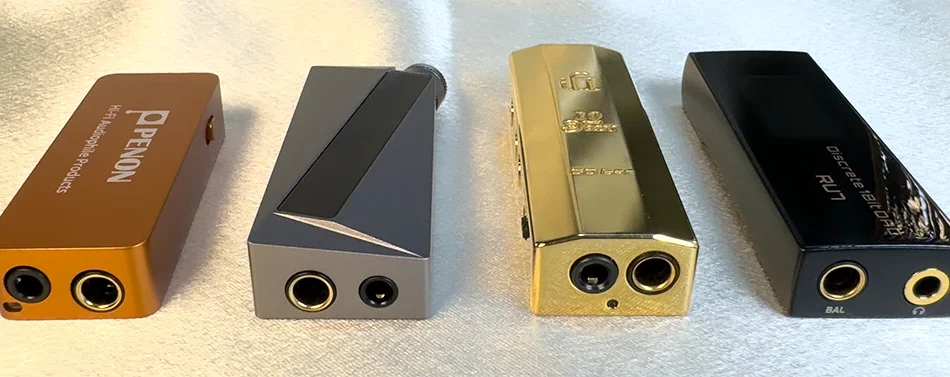Penon Tail Review

One of the nice things about this hobby is watching the endless march of technology render quality sound we would’ve paid a fortune for years ago become available for a mere fraction of the cost.
This is especially relevant to dongles, which have really gained popularity among audiophiles over the past several years.
It’s no surprise Penon have jumped onboard by developing their own Tail dongle. At under USD $75 its quite affordable, so when they offered to send me one in exchange for a review I was keen to learn how it stacks up against more expensive options.
What I’ve discovered is the Tail has all the sonic hallmarks of a Penon-tuned product.
Packaging
The USD $74 Penon Tail arrives in a small cardboard box, inside of which is a plastic hard case, a small leather accessories case and two cables, one USB-C to USB-C and the other USB-C to Lightning.
The plastic hard case is especially handy for carrying the dongle, a USB cable and perhaps a few sets of eartips and is something I wish other manufacturers included.
Features & Ergonomics

As you’d expect from its’ lower price the Tail isn’t as impressive from a tech perspective as some of its’ rivals, but is still a fully-fledged dongle with everything you need. Sporting dual CS43131 DACs the Tail delivers 290mW to its’ 4.4mm jack, and supports PCM to 384kHz and DSD up to DSD256.
The Tail has two gains modes that are switchable with a physical button, there’s also two buttons for volume up and down and another for play/pause.
At 17.9 grams the Tail is the lightest dongle I’ve tried, yet its’ aluminium case feels smooth & durable. There isn’t quite the visual panache we see from more expensive dongles, but given the Tail’s modest price that feels acceptable.
Sound Performance
I tested the Tail with a USB-C iPhone 15 Pro & M1 Macbook Air, using Noble Audio Spartacus IEMs.
The Tail has a very neutral, clean signature with powerful bass output, that also delivers the kind of forward midrange performance Penon has become known for. Sub bass in particular is quite elevated and bass texture is impressive, but midbass is kept in check to prevent excessive warmth from robbing the presentation of its’ neutrality, though the Tail never sounds cold or clinical.
Typical of Penon’s tuning is the impressive midrange resolution which allows vocals to grab & hold your attention very effectively, though I wouldn’t go so far as to categorise the Tail as mid-centric. Treble is a touch muted, and lacks the polish more expensive dongles provide. As a result tiny details in the upper frequencies can be obscured which might otherwise provide a greater sense of refinement.
On the technical front the soundstage is quite wide but stage depth lags behind that of expensive dongles, imaging isn’t bad but could be a touch more defined, and note weight is average. Dynamics however are very good, and overall resolution is commendable in the midrange but less impressive at either end of the frequency spectrum, without being low enough to be a problem.
Dongle Comparisons

iFi Go Bar 10th Anniversary (USD $499)
Background noise is much higher on the 10th Anniversary, bass is punchier with more midbass output.
The 10th Anniversary is more coloured & less neutral, with more aggressiveness & note weight, slightly more soundstage depth, though resolution feels similar between the two as does imaging & dynamics.
Cayin RU7 (USD $289)
Despite the Tail’s impressive midrange the RU7 goes up another notch in that area with even richer, higher resolution vocals with greater lower midrange emphasis.
The RU7’s deeper soundstage feels more spacious, imaging is slightly clearer, dynamics are even higher despite the TAIL being no slouch in that area, and the RU7’s tonality is more relaxed and organic with slightly better note weight though the Tail may have a bit more groove & musicality.
Luxury & Precision W4 (USD $449)
The W4 really steps things up across the board with greater resolution across all frequencies, with higher quality treble being a particular standout.
In fact it’s the difference in technical performance rather than tonality that separates these two dongles as they’re both fairly neutral, with the W4 displaying clearer separation & imaging in a better organised stage, improved dynamics, more defined attack on individual notes and a deeper soundstage.
Conclusion

The Penon Tail is light on features but heavy on value. If you’re looking for a toe-tapping source with a great midrange to pair with your phone or laptop I’m not sure you can do much better for $75.
Penon’s tuning philosophy is one with broad-based appeal, ironically especially here in the West despite Penon being an Eastern brand. Western audiophiles tend to love deep bass with warmer lower mids & treble kept in check, which is often the flavour of Penon products.
The Tail remains neutral enough it should pair quite well with most IEMs you throw at it, but there’s enough of that Penon flavour that it’s easy to recommend.
You can spend 3 or 4 times as much on a different dongle and get a bit more refinement & slightly stronger technicalities, but unless you’ve already spent over $1000 on your earphones you’ll generally get more value saving on your source to spend more on better IEMs.
It’s nice to see Penon branching out into different areas because when it comes to tuning audio products they know their stuff… hopefully there’s a Penon portable amp or DAP on the horizon!
Introduction
Luxury & Precision W4 Review
iFi Go Bar 10th Anniversary Review
Cayin RU7 Review
Penon Tail Review
Dongle Shootout Summary



better use better devices as souce